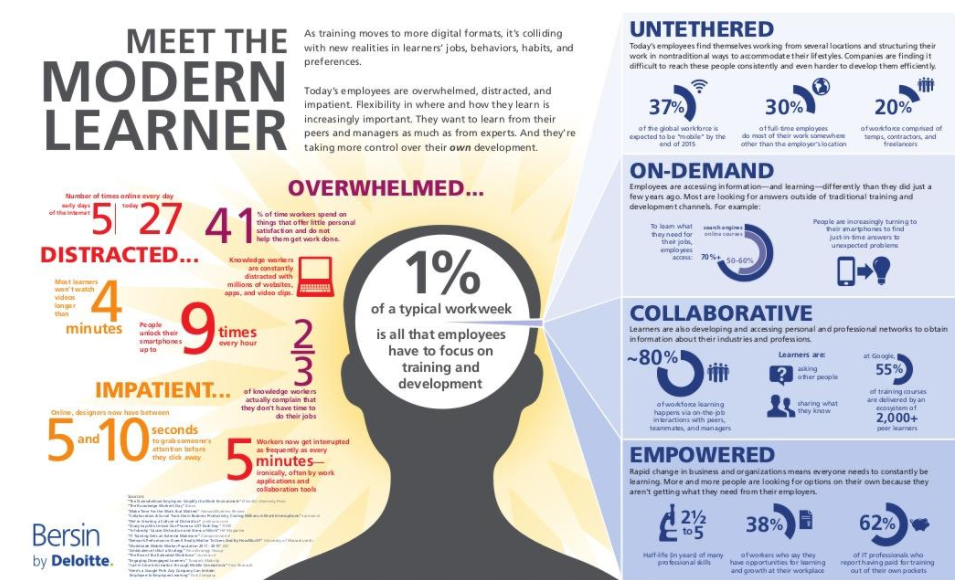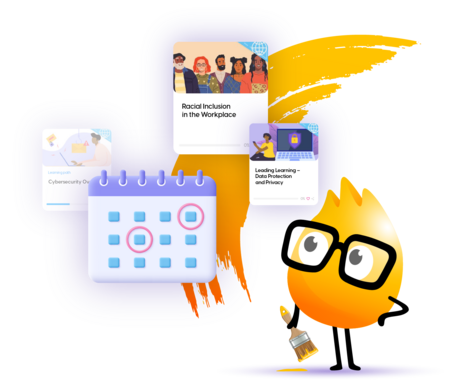Solving the Challenge of Today’s Learners
Wow, has time flown by! It seems like just yesterday we were gathered at the C3 conference, learning and experiencing new and interesting CallidusCloud developments.
While I was there, I had the pleasure to meet and speak with a variety of people from different industries, one thing was constant…how can we help the people in our organizations be the best they can be? How can we help them be more proactive in their own growth and development? It seems that no matter who I speak with, we all are struggling to find the answers.
Key to getting to the root of the issues is first understanding the challenges people face in the work place today.
I displayed this graphic during my session about Simplicity in Learning during the conference. This graphic from Bersin by Deloitte tells us the story about the modern learner.
Beyond this, here are some numbers I’d like you to consider.
- 2 out of 3 people don’t have time in a day to do their jobs to the best of their abilities
- People spend 21% of their time just looking up stuff
- Fewer than 15% of workers apply what they learned in formal training to their day to day jobs
Those figures made me sit up and take notice but what does it all mean? It means we need to spend less time solving problems that might happen and more time solving problems that are happening.
People have less and less time to spend in formal training environments, be they in the classroom or virtual environment – this means we must focus on creating programs with purpose. Here are some guidelines for helping the humans in our organizations meet and beat the challenge of balancing work with professional development.
- Is your program truly solving a problem for a the person or the organization? Many times, we create programs with the reasoning of, “They need to know…” Do they really need to know and then be tested on the history of OSHA in order to solve the problem of people recognizing defective ladders? (When was the OSHA department initiated? This was an actual test question from a training program to the participants. Don’t do this.)
- Ask yourself, how is this program helping people to do their jobs faster, cheaper, better? If your program is not addressing one of these issues, it’s time to go back and start over.
- Mass training may be efficient but it’s not effective. If your goal is to waste company cash, then, yes – you’ve achieved your goal. If not, you need to target the audience toward the specific need of the participants. No, it’s not easy – but it’s critical to training success.
- Know exactly what people are supposed to be able to do upon conclusion of the program. If your program is knowledge based, it shouldn’t be a course. Most likely it’s reference. Make a video, create a screencast, write a blog post. Let’s help people by not taking away valuable time from the job.
- Discard the bloat. People do not need to know the history of time to tell the time. Go back up to item #1. Discover what problem you are trying to solve and solve that problem. People don’t have time for the backstory. If the problem we are trying to solve is about ladder safety, then everything within the program should point back to the solving the ladder problem. This is not the time to throw in information about how to assess a safety harness. The more bloat we eliminate, the faster we get to the point and the likelihood of success grows.
- More times than not, a fat course is a skinny job aid dying to get out. Give that some thought. Are you making a course out of a job aid?
Recent industry research through the Association of Talent Development tells us it takes anywhere from 43 – 185 hours of development time to create one hour of training. I am of the mindset that we don’t have that kind of time anymore. Business moves fast and it expects us, as L&D people, to keep up. This means that the targeted approach in my tips above, must be paramount to any development. Creating bloated content takes longer to create than skinny content.
On the plus side, people are more interested and engaged in content that is highly relevant and crucially important to what they do every day. What to solve the problem of people not being motivated to learn? Give them something worth learning.
Simplicity in learning design helps all of us, it helps us to create content with purpose – and it helps the humans in our organization do their jobs better. Ultimately, helping people be the best they can be on the job.
Isn’t that why we do what we do?






